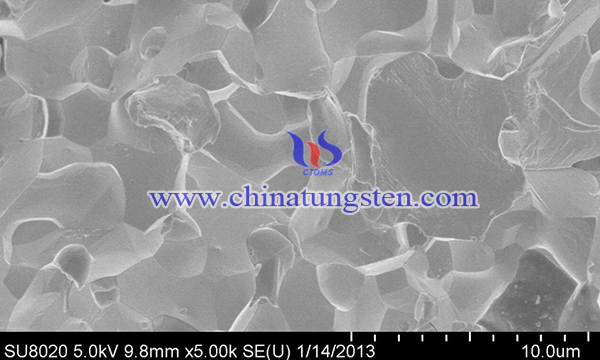Tungsten–Praseodymium Oxide Composite with Enhanced Physical Properties Prepared by Ammonium Paratungstate
- Details
- Category: Tungsten Information
- Published on Sunday, 01 August 2021 12:37
Tungsten is a metal with the highest melting point of 3440 °C. Its excellent physical properties, such as good thermal conductivity and low thermal expansion coefficient, make it widely used in high-temperature applications, including aerospace, nuclear, and the national defence industry. One of the significant applications of tungsten is plasma-facing material, which faces a harsh environment such as high temperature, high nuclear irradiation.

Tungsten faces several problems as plasma-facing material: high-temperature brittleness, recrystallization brittleness and radiation-induced brittleness. Concerning additional phases, research has focused on the dispersion of second-phase particles, either carbides or rare earth oxides. This method is considered to be able to enhance the physical properties of tungsten powder.
Thus, tungsten–praseodymium oxide composite (Pr2O3/W) was prepared by ammonium paratungstate (APT). The physical properties of tungsten were extensively improved by doping of praseodymium (Pr2O3). The synthesis process of Pr2O3/W composite is as following steps:

Initially, 30 g of APT and 0.56 g of praseodymium nitrate (PrN3O9⋅6H2O) were dissolved in sequence in 150 ml of deionized water under vigorous stirring at room temperature. The solution was filtered after a 24 h reaction to ensure complete reaction between APT and Pr ions, and the obtained powder was dried at 60 °C for two h. The powder was then calcined under a nitrogen atmosphere at 450 °C for one h whereby the powder was transformed into an oxide mixture. Next, the precursor was reduced by high purity hydrogen in a single-tube electrically heated furnace. The boat containing the precursor was placed in the central section of the furnace tube and heated to 800 °C at five °C/min in a gas flow, then maintained at that temperature for six h. After that, the sample was cooled to room temperature, still under a hydrogen flow. In a separate experiment, the as-received APT was reduced to pure tungsten powder under the same conditions.
The consolidation of the samples was carried out through SPS (FCT Group, SE-607, Germany) technique. The temperature profile of the sintering program in this study was illustrated in Fig. 1. Under the action of a uniaxial pressure increased slowly to 43.3 MPa, the powders were heated by pulse current to 450 °C. Then under the constant pressure of 43.3 MPa, the powders were heated to 700 °C with a heating rate of 50 °C/min. The powders were held at 700 °C for 2 min, and the pressure was increased from 43.3 MPa to 57 MPa at the same time. All these above sintering processes were conducted in a vacuum. Then a flowing gas mixture of argon and hydrogen atmosphere was used for the following sintering processes. The samples were heated to 1300 °C with a heating rate of 100 °C/min and held at 1300 °C for 20 min. Subsequently, the samples were heated to 1800 °C at a heating rate of about 100 °C/min, and after 2 min soaking, they were cooled down to room temperature with a cooling rate of 100 °C/min. The size of the sintered samples was about 20 mm in diameter and 2.0–3.0 mm in thickness. Densities measurements of sintered samples were conducted by the Archimedes method. The relative densities (RD) were calculated using the theoretical densities of tungsten and Pr2O3 as 19.3 g/cm3 and 6.85 g/cm3. Polished sintered samples were subjected to Vickers microhardness testing under 200 g loads and a dwell time of 20 s at room temperature. The Vickers microhardness was calculated as a mean of ten measurements.
In summary, tungsten–praseodymium oxide composite (Pr2O3/W) was prepared by ammonium paratungstate (APT) using a wet chemical method and SPS sintering. The physical properties of tungsten were extensively improved by doping of praseodymium (Pr2O3). The SEM images revealed that Pr2O3 particles are homogeneously distributed in the tungsten matrix. The grain size, relative density and the Vicker hardness HV0.2 of the bulk samples fabricated by SPS sintering were four μm, 98.3% and 377.2, respectively. The tensile strength values of Pr2O3/W samples were higher than those of pure tungsten.
- APT Manufacturer & Supplier, Chinatungsten Online: ammonium-paratungstate.com
- Tungsten News & Prices of China Tungsten Industry Association: www.ctia.com.cn
- Molybdenum News & Price: news.molybdenum.com.cn
- Tel.: 86 592 5129696; Fax: 86 592 5129797; Email: sales@chinatungsten.com



 sales@chinatungsten.com
sales@chinatungsten.com